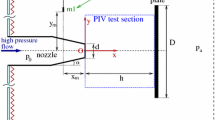Abstract
Unsteady impinging jets are systematically controlled with respect to their time dependence in order to investigate the influence of unsteadiness on the heat transfer performance. This is achieved by a special mass flow control device, which allows almost arbitrary shapes of unsteadiness to be imposed onto the impinging jet. Three different standard signals (sinusoidal, triangular, rectangular) and two specially designed signals are applied and their influence on heat transfer is determined in terms of an enhancement factor. Heat transfer augmentation up to 30% was found and could be physically explained with the help of PIV and hot-wire measurements of the flow field.


















Similar content being viewed by others
Abbreviations
- A :
-
Area (m2)
- D :
-
Nozzle diameter (m)
- f :
-
Frequency (Hz)
- F :
-
Dimensionless function (–)
- H :
-
Nozzle-to-plate distance (m)
- I :
-
Electrical current (A)
- k :
-
Thermal conductivity (W/mK)
- \( \dot{m} \) :
-
Mass flow rate (kg/s)
- n :
-
Counter (–)
- N :
-
Number of samples (–)
- Nu :
-
Nusselt number (–)
- Pr :
-
Prandtl number (–)
- \( \dot{q} \) :
-
Heat flux density (W/m2)
- r :
-
Radial distance, radius (m)
- R :
-
Electrical resistance (Ω)
- Re :
-
Reynolds number (–)
- s :
-
Input signal (V)
- S :
-
Material thickness (m)
- T :
-
Temperature (K)
- u :
-
Velocity (m/s)
- U :
-
Voltage (V)
- α :
-
Electrical resistance coefficient (1/K)
- Λ:
-
Enhancement coefficient (–)
- μ :
-
Dynamic viscosity (Pa s)
- ρ :
-
Density (kg/m3)
- τ :
-
Time (s)
- τ s :
-
Period length (s)
- \( \hat{\tau } \) :
-
Integration time (s)
- Φ:
-
Phasing (–)
- A :
-
Area
- AMB:
-
Ambient
- c:
-
Conduction
- cl:
-
Centerline
- conv:
-
Convection
- e:
-
Electrical
- F:
-
Fluid
- i :
-
Isolation
- m:
-
Area mean
- R:
-
1. Rectangular
2. Reference
- S:
-
1. Surface
2. Sinusoidal
- SF:
-
Single field
- st:
-
Steady
- T:
-
Triangular
- 0:
-
At 0°C
- –:
-
Time mean
References
Göppert S, Gürtler T, Mocikat H, Herwig H (2004) Heat transfer under a precessing jet: effects of unsteady jet impingement. Int J Heat Mass Transfer 47:2795–2806
Jambunathan K, Lai E, Moss M, Button B (1992) A review of heat transfer data for single circular jet impingement. Int J Heat Fluid Flow 13:106–115
Martin H (1977) Heat and mass transfer between impinging gas jets and solid surface. Adv Heat Transf 13:1–60
VDI-Gesellschaft Verfahrenstechnik und Chemieingenieurwesen (GVC) (2006) VDI-Wärmeatlas. Springer, Berlin
Azevedo LFA, Webb BM, Queiroz M (1994) Pulsed air jet impingement heat transfer. Exp Therm Fluid Sci 8(3):206–213
Sailor DJ, Rohli DJ, Fu Q (1999) Effect of variable duty cycle flow pulsations on heat transfer enhancement for an impinging air jet. Int J Heat Fluid Flow 20:574–580
Herwig H, Mocikat H, Gürtler T, Göppert S (2004) Heat transfer due to unsteadily impinging jets. Int J Therm Sci 43:733–741
Nevins, R.G.; Ball, HD (1961) Heat transfer between a flat plate and a pulsating impinging jet. In: Proceedings of national heat transfer conference, Boulder, CO, pp 510-516
Herwig H, Middelberg G (2008) The physics of unsteady jet impingement and its heat transfer performance. Acta Mechanica 201:171–184
Zhou JW, Wang G, Middelberg G, Herwig H (2008) Unsteady jet impingement: heat transfer on smooth and non-smooth surfaces. Commun Heat Mass Transf 36:103–110
Durst F, Heim U, Ünsal B, Kullik G (2003) Mass flow rate control system for time-dependent laminar and turbulent flow investigations. Measurement Sci Technol 14:893–902
Yule AJ (1978) Large-scale structure in the mixing layer of a round jet. J Fluid Mech 89:413–432
Kataoka K, Suguro M, Degawa H, Maruo K, Mihata I (1987) The effect of surface renewal due to large-scale eddies on jet impingement heat transfer. Int J Heat Mass Transf 30:559–567
Glezer A, Amitay M (2002) Synthetic jets. Ann Rev Fluid Mech 34:503
Bremhorst K, Hollis G (1990) Velocity Field of an axisymmetric pulsed, subsonic air jet. AIAA J 28(12):2043–2049
Lai H, Naughton JW, Lindberg WR (2003) An experimental investigation of starting impinging jets. J Fluids Eng 125(2):275–282
Acknowledgments
The authors wish to thank the DFG (Deutsche Forschungsgemeinschaft) for their support of this study. They also want to thank Dr. Sid Becker, North Carolina State University and Humboldt Fellow at TU Hamburg-Harburg, for his assistance in preparing the final version of this paper.
Author information
Authors and Affiliations
Corresponding author
Rights and permissions
About this article
Cite this article
Middelberg, G., Herwig, H. Convective heat transfer under unsteady impinging jets: the effect of the shape of the unsteadiness. Heat Mass Transfer 45, 1519–1532 (2009). https://doi.org/10.1007/s00231-009-0527-4
Received:
Accepted:
Published:
Issue Date:
DOI: https://doi.org/10.1007/s00231-009-0527-4




